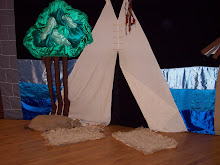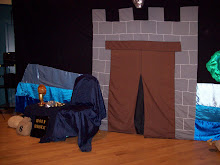Embracing the past: Haitian troupe tells painful story of slavery and genocide, points to path of healing in: “Three Innocents and a Spirit” The stylized and intimate drama, “Three Innocents and a Spirit,” explores the impact of a colonial clash of cultures, even as it seeks to clarify the issues and heal historical wounds. The creative force behind this historical piece is the N a Sonje Foundation, a group from Haiti that strives to contribute to global awareness and social memory through performance and tactile experience.
N a Sonje’s name is a Creole phrase that translates as “we will remember.” The affirmation serves as the organization’s mission statement, as the three-person troupe seeks most of all to heal historical wounds through artistic activism. Photos by Leah Bluntschli • Left: Djalòki Ntjitjagagi Jean Luc Dessables, representing the Native American people, offers a peace pipe as a healing gesture to the African and European peoples at the end of the performance of “Three Innocents and a Spirit” Feb. 12 at Atonement Lutheran church, Denver.."Three Innocents and a Spirit” is an ambitious historical tableau, a condensed piece of stagecraft that encompasses over 500 years of history. The cast of characters is small, but the simplistic approach manages to encapsulate a stunning menu of times, places and personas. The cast members’ interactions symbolize the contact between nations and cultures, and the result is impressive in its potent message. The performance is completely mimed and the absence of dialogue only heightens the effect of the drama’s themes and statements. The tragic tale of colonialism is told in sounds, gestures and songs. Here, the topics are so vast and important that no words can properly capture their import. There is something utterly effective in the stark and simple approach.
Photos by Leah Bluntschli • Left: Djalòki Ntjitjagagi Jean Luc Dessables, representing the Native American people, offers a peace pipe as a healing gesture to the African and European peoples at the end of the performance of “Three Innocents and a Spirit” Feb. 12 at Atonement Lutheran church, Denver.."Three Innocents and a Spirit” is an ambitious historical tableau, a condensed piece of stagecraft that encompasses over 500 years of history. The cast of characters is small, but the simplistic approach manages to encapsulate a stunning menu of times, places and personas. The cast members’ interactions symbolize the contact between nations and cultures, and the result is impressive in its potent message. The performance is completely mimed and the absence of dialogue only heightens the effect of the drama’s themes and statements. The tragic tale of colonialism is told in sounds, gestures and songs. Here, the topics are so vast and important that no words can properly capture their import. There is something utterly effective in the stark and simple approach.
Although “Spirit” tells the story of Western colonialism from a uniquely Haitian perspective, the story involves a global cast of characters that reaches over generations. Christopher Columbus landed with his fleet in what is now Haiti in 1492. Believing he had reached India, the Italian explorer labeled the natives “Indians” and sparked a long and painful process of conversion, colonization and dehumanization. The consequences of Columbus’ arrival were far-reaching. Haiti soon fell under Spanish occupation and the native Taino population was decimated by disease, massacres and slavery. The 4 million to 5 million Tainos who inhabited the Haitian islands before 1492 were quickly eradicated and, in 1503, the first black slaves landed on Haitian shores to take their place. As in the Americas, as in Africa, as in all the sites where human souls are sold like chattel and the land is a commodity traded between bureaucracies, a cycle of tragedy, revolt and violence followed. “Spirit” explores the impact on all parties involved. The central theme of the drama is the lasting impact of historical crimes. The consequences of slavery and domination impact the colonizers as well as the colonized, the victims of violence as well as its perpetrators. With limited resources and a minimalist dramatic approach, the N a Sonje troupe transports viewers through the ages as it awakens themto the past and the present that binds us all. By Adam Goldstein • goldstea@mscd.edu
N a Sonje’s name is a Creole phrase that translates as “we will remember.” The affirmation serves as the organization’s mission statement, as the three-person troupe seeks most of all to heal historical wounds through artistic activism.
 Photos by Leah Bluntschli • Left: Djalòki Ntjitjagagi Jean Luc Dessables, representing the Native American people, offers a peace pipe as a healing gesture to the African and European peoples at the end of the performance of “Three Innocents and a Spirit” Feb. 12 at Atonement Lutheran church, Denver.."Three Innocents and a Spirit” is an ambitious historical tableau, a condensed piece of stagecraft that encompasses over 500 years of history. The cast of characters is small, but the simplistic approach manages to encapsulate a stunning menu of times, places and personas. The cast members’ interactions symbolize the contact between nations and cultures, and the result is impressive in its potent message. The performance is completely mimed and the absence of dialogue only heightens the effect of the drama’s themes and statements. The tragic tale of colonialism is told in sounds, gestures and songs. Here, the topics are so vast and important that no words can properly capture their import. There is something utterly effective in the stark and simple approach.
Photos by Leah Bluntschli • Left: Djalòki Ntjitjagagi Jean Luc Dessables, representing the Native American people, offers a peace pipe as a healing gesture to the African and European peoples at the end of the performance of “Three Innocents and a Spirit” Feb. 12 at Atonement Lutheran church, Denver.."Three Innocents and a Spirit” is an ambitious historical tableau, a condensed piece of stagecraft that encompasses over 500 years of history. The cast of characters is small, but the simplistic approach manages to encapsulate a stunning menu of times, places and personas. The cast members’ interactions symbolize the contact between nations and cultures, and the result is impressive in its potent message. The performance is completely mimed and the absence of dialogue only heightens the effect of the drama’s themes and statements. The tragic tale of colonialism is told in sounds, gestures and songs. Here, the topics are so vast and important that no words can properly capture their import. There is something utterly effective in the stark and simple approach.Although “Spirit” tells the story of Western colonialism from a uniquely Haitian perspective, the story involves a global cast of characters that reaches over generations. Christopher Columbus landed with his fleet in what is now Haiti in 1492. Believing he had reached India, the Italian explorer labeled the natives “Indians” and sparked a long and painful process of conversion, colonization and dehumanization. The consequences of Columbus’ arrival were far-reaching. Haiti soon fell under Spanish occupation and the native Taino population was decimated by disease, massacres and slavery. The 4 million to 5 million Tainos who inhabited the Haitian islands before 1492 were quickly eradicated and, in 1503, the first black slaves landed on Haitian shores to take their place. As in the Americas, as in Africa, as in all the sites where human souls are sold like chattel and the land is a commodity traded between bureaucracies, a cycle of tragedy, revolt and violence followed. “Spirit” explores the impact on all parties involved. The central theme of the drama is the lasting impact of historical crimes. The consequences of slavery and domination impact the colonizers as well as the colonized, the victims of violence as well as its perpetrators. With limited resources and a minimalist dramatic approach, the N a Sonje troupe transports viewers through the ages as it awakens themto the past and the present that binds us all. By Adam Goldstein • goldstea@mscd.edu













